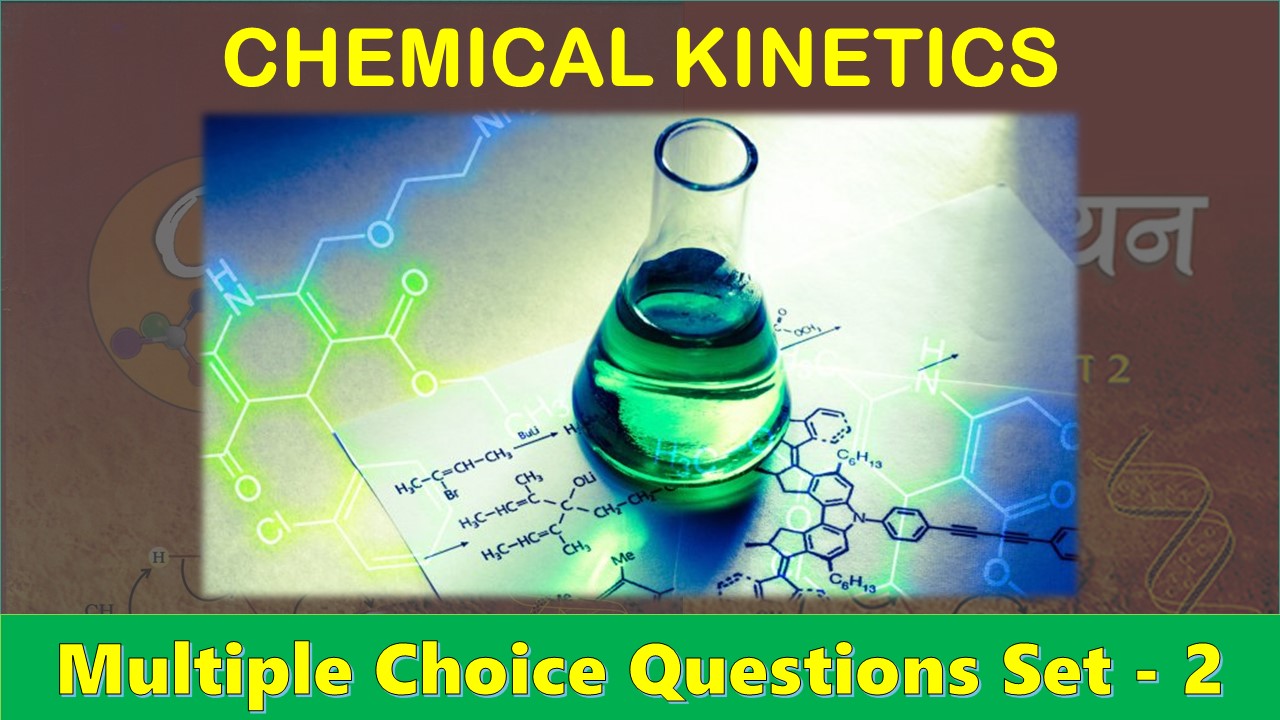CBSE Class 12 Chemical Kinetics Multiple Choice Questions with Answers. MCQ Questions Class 12 Chemical Kinetics with Answers Is Prepared Based on Latest Exam Pattern. Students can solve NCERT Class 12 Chemical Kinetics MCQs with Answers to know their preparation level.
Students who are searching for NCERT MCQ Questions for Class 12 Chemical Kinetics with Answers are compiled here to get good practice on all fundamentals. Know your preparation level on MCQ Questions for Class 12 Chemical Kinetics with Answers. You can also verify your answers from our provided MCQ Class 12 Chemical Kinetics with Answers. So, ace up your preparation with MCQ of Class 12 Chemistry Examinations.
MCQ Questions Class 12 Chemical Kinetics with Answers - Set - 2
Question 1:
A reaction is 50% complete in 2 hours and 75% complete in 4 hours. The order of reaction is
(a) 1
(b) 2
(c) 3
(d) 0
Correct Answer – (A)
Question 2 :
The rate of first-order reaction is 0.04 mol L–1 s–1 at 10 seconds and 0.03 mol L–1 s–1 at 20 seconds after initiation of the reaction. The half-life period of the reaction is
(a) 44.1 s
(b) 54.1 s
(c) 24.1 s
(d) 34.1 s
Correct Answer – (C)
Question 3 :
When initial concentration of the reactant is doubled, the half-life period of a zero order reaction
(a) is halved
(b) is doubled
(c) is tripled
(d) remains unchanged.
Correct Answer – (B)
Question 4 :
A first order reaction has a rate constant of 2.303 × 10–3 s–1. The time required for 40 g of this reactant to reduce to 10 g will be [Given that log10 2 = 0.3010]
(a) 230.3 s
(b) 301 s
(c) 2000 s
(d) 602 s
Correct Answer – (D)
Question 5 :
The rate constant for a first order reaction is 4.606 × 10–3 s–1. The time required to reduce 2.0 g of the reactant to 0.2 g is
(a) 100 s
(b) 200 s
(c) 500 s
(d) 1000 s
Correct Answer – (C)
MCQ Questions Class 12 Chemical Kinetics with Answers
Question 6:
When initial concentration of a reactant is doubled in a reaction, its half-life period is not affected. The order of the reaction is
(a) second
(b) more than zero but less than first
(c) zero
(d) first.
Correct Answer – (D)
Question 7:
A first order reaction has a specific reaction rate of 10–2 sec–1. How much time will it take for 20 g of the reactant to reduce to 5 g?
(a) 138.6 sec
(b) 346.5 sec
(c) 693.0 sec
(d) 238.6 sec
Correct Answer – (A)
Question 8:
The correct difference between first and second order reactions is that
(a) the rate of a first-order reaction does not depend on reactant concentrations; the rate of a second-order reaction does depend on reactant concentrations
(b) the half-life of a first-order reaction does not depend on [A]0 ; the half-life of a second-order reaction does depend on [A]0
(c) a first-order reaction can be catalysed; a secondorder reaction cannot be catalysed
(d) the rate of a first-order reaction does depend on reactant concentrations; the rate of a secondorder reaction does not depend on reactant concentrations.
Correct Answer – (B)
Question 9:
If the rate constant for a first order reaction is k, the time (t) required for the completion of 99% of the reaction is given by
(a) t = 2.303/k
(b) t = 0.693/k
(c) t = 6.909/k
(d) t = 4.606/k
Correct Answer – (D)
Question 10:
The given reaction,
2FeCl3 + SnCl2 → 2FeCl2 + SnCl4 is an example of
(a) third order reaction
(b) first order reaction
(c) second order reaction
(d) none of these.
Correct Answer – (A)
- NCERT Solutions Class 11 Chemistry Chapter 1 : Some Basic Concepts of Chemistry
- NCERT Solutions Class 11 Chemistry Chapter 2 : Structure Of The Atom
- NCERT Solutions Class 11 Chemistry Chapter 3 : Classification of Elements and Periodicity in Properties
- NCERT Solutions Class 11 Chemistry Chapter 4 : Chemical Bonding and Molecular Structure
- NCERT Solutions Class 11 Chemistry Chapter 5 : States of Matter
- NCERT Solutions Class 11 Chemistry Chapter 6 : Thermodynamics
- NCERT Solutions Class 11 Chemistry Chapter 7 : Equilibrium
- NCERT Solutions Class 11 Chemistry Chapter 8 : Redox Reactions
- NCERT Solutions Class 11 Chemistry Chapter 9 : Hydrogen
- NCERT Solutions Class 11 Chemistry Chapter 10 : The s-Block Elements
- NCERT Solutions Class 11 Chemistry Chapter 11 : The p-Block Elements
- NCERT Solutions Class 11 Chemistry Chapter 12 : Organic Chemistry: Some Basic Principles and Techniques
- NCERT Solutions Class 11 Chemistry Chapter 13 : Hydrocarbons
- NCERT Solutions Class 11 Chemistry Chapter 14 : Environmental Chemistry



